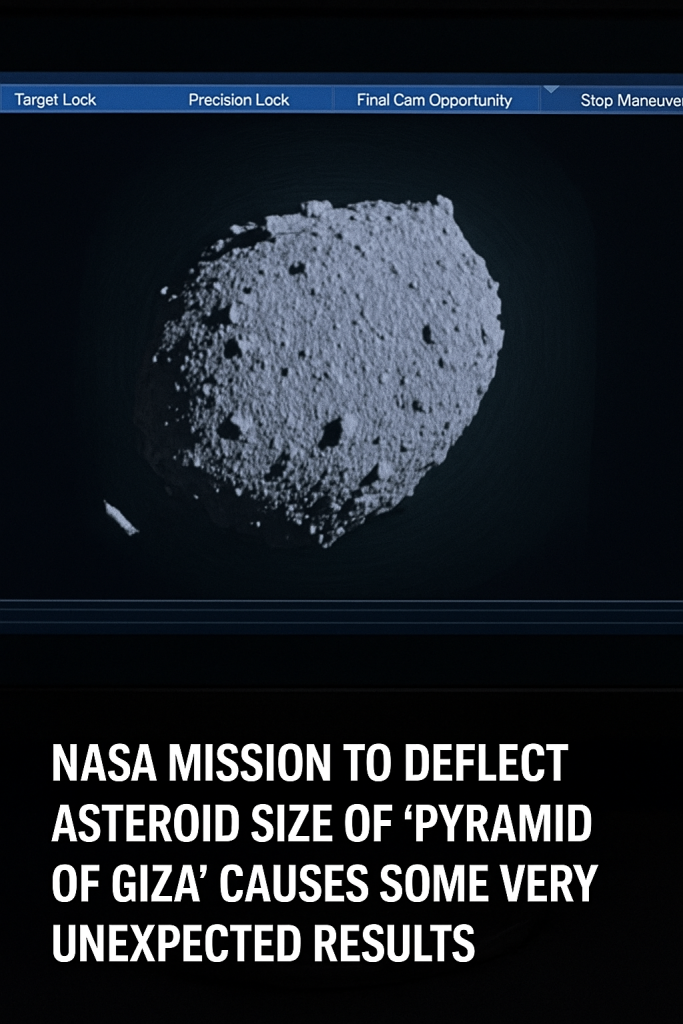In a groundbreaking achievement for planetary defense, NASA’s Double Asteroid Redirection Test (DART) mission has successfully smashed its satellite into a distant asteroid, marking the first-ever demonstration of humanity’s ability to alter the trajectory of a celestial object. This milestone event took place recently when NASA targeted a small, pyramid-sized asteroid, a technique that could safeguard Earth from potentially hazardous space objects in the future.
The DART spacecraft deliberately collided with the asteroid known as Dimorphos, the smaller companion in a binary asteroid system, traveling at a speed fast enough to shift its orbit through kinetic impact. This monumental feat was captured live, with NASA providing a real-time “Target Lock” precision control feed, showcasing the spacecraft’s final approach and impact moments.
The mission’s objective was clear: test the viability of deflecting an asteroid by striking it with a high-velocity impactor, a strategy considered one of the most promising methods for planetary defense. The asteroid Dimorphos is estimated to be roughly the size of the Great Pyramid of Giza, making it an ideal test subject due to its manageable size and orbital characteristics.
Live Coverage and Precision Targeting
Leading up to the collision, the DART team engaged a “Target Lock” system that precisely guided the spacecraft to its impact point. The meticulous approach captured the imaginations of viewers worldwide, as NASA streamed live footage showing the spacecraft’s final seconds gliding into the asteroid.
The impact generated immediate excitement among scientists and space enthusiasts, as initial telemetry data suggested a successful collision that imparted enough force to alter Dimorphos’ orbital path around its larger companion, Didymos. This change in orbit, though subtle, is a critical proof of concept that could translate into life-saving technology in the event of a future asteroid threat.
Scientific Significance and Future Implications
The DART mission stands as humanity’s first deliberate attempt to change the motion of an object in space, an endeavor that has profound implications for global security and space science. The project provides crucial insights into the composition and structure of asteroids, which will inform more effective strategies for planetary defense.
Following the collision, numerous observatories worldwide initiated observation campaigns to measure the change in Dimorphos’ orbit around Didymos, helping confirm the mission’s success. NASA has indicated that these follow-up observations will continue for months, refining our understanding of the kinetic impact technique’s effectiveness.
“The success of the DART mission ushers in a new era for planetary defense,” said mission leaders. The ability to deflect an asteroid adds a critical tool to humanity’s protective measures against cosmic threats, shifting asteroid collision avoidance from theory to practiced reality.
Public Engagement and the Path Ahead
The DART mission not only advanced scientific frontiers but also ignited public fascination with space defense. NASA’s clear communication and live broadcasts kept millions glued to their screens, highlighting the importance of planetary defense as a shared human endeavor.
Encouraged by this success, NASA plans further testing and improvements in asteroid deflection technology. While space remains a dynamic environment with many unknowns, DART’s achievement provides a hopeful precedent that humans can actively protect their planet with careful planning and advanced technology.
In summary, the DART mission’s successful satellite collision with a pyramid-sized asteroid offers a compelling demonstration of humanity’s growing capabilities to safeguard Earth from potential cosmic hazards — a historic leap forward in space exploration and planetary defense.



